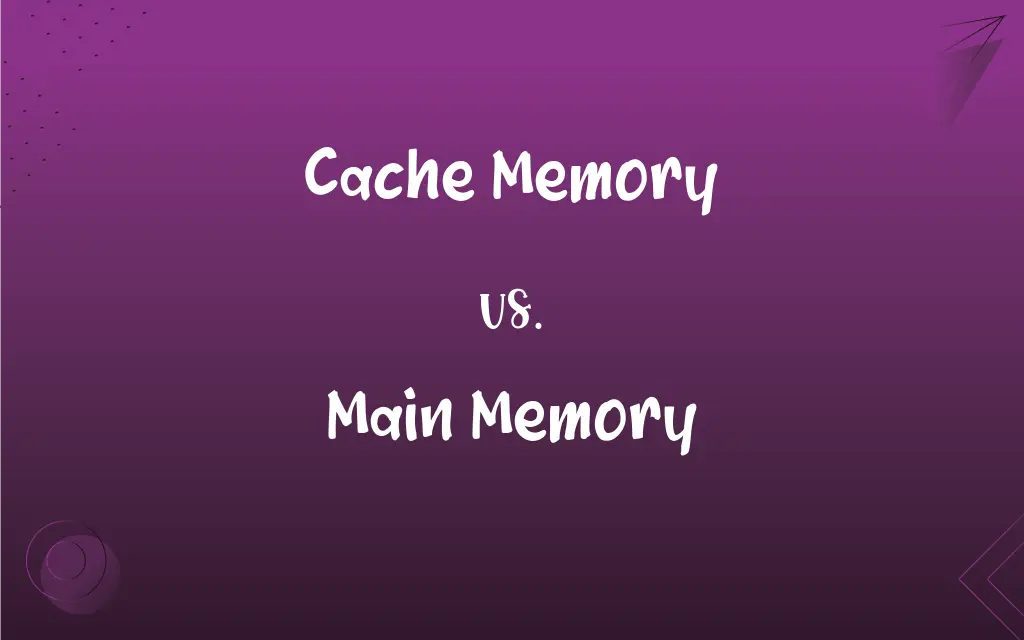Cache Memory vs. Main Memory: What's the Difference?
Edited by Aimie Carlson || By Janet White || Published on February 17, 2024
Cache memory is a small, fast memory layer storing frequently accessed data, while main memory (RAM) is larger, slower, and stores data currently in use.

Key Differences
Cache memory is designed for speed, providing quick access to frequently used data and instructions. Main memory, also known as Random Access Memory (RAM), holds data that the CPU is currently processing. While cache memory enhances processing speed by reducing data access time, main memory provides the bulk storage necessary for active processes.
The capacity of cache memory is significantly smaller compared to main memory, optimized for speed rather than storage. Main memory has a much larger capacity, designed to store a wide range of data and programs in active use. Cache memory’s limited size makes it faster but less capable of holding large amounts of data like main memory.
Cache memory is typically integrated directly into the CPU or very close to it, minimizing latency. Main memory is separate from the CPU, connected via a memory bus, leading to higher latency compared to cache memory. The proximity of cache memory to the CPU significantly speeds up data retrieval, a contrast to the relatively slower access speed of main memory.
In terms of hierarchy and function, cache memory serves as an intermediary between the CPU and main memory. While main memory holds all active data and instructions, cache memory selectively stores the most accessed elements to improve processing speed. The interaction between these two types of memory is crucial for efficient computer operation.
The cost per bit of cache memory is higher than that of main memory due to its advanced speed and technology. Conversely, main memory is more cost-effective for bulk storage but offers slower access speeds. The balance between the cost and speed of cache and main memory is key to computer performance optimization.
ADVERTISEMENT
Comparison Chart
Speed
Extremely fast access time
Slower access time compared to cache memory
Capacity
Small, designed for temporary, frequent data
Large, stores a wide range of active data and programs
Location
Close to or within the CPU
Separate from the CPU
Function
Speeds up data access for the CPU
Holds all active data and instructions for the CPU
Cost
Higher cost per bit
More cost-effective for storage
ADVERTISEMENT
Cache Memory and Main Memory Definitions
Cache Memory
High-cost, efficient memory for enhancing processing speed.
Despite its cost, cache memory is vital for fast computer operations.
Main Memory
Volatile memory that retains data only while powered.
Main memory loses its data when the computer is turned off.
Cache Memory
A small-sized, fast memory storing frequently accessed data.
The CPU retrieves data from cache memory to speed up processing.
Main Memory
Slower, cost-effective memory connected via a memory bus.
Data travels from main memory to the CPU through the memory bus.
Cache Memory
Temporary storage for quick access to important data.
Cache memory holds frequently used instructions for immediate use.
Main Memory
Larger capacity memory, also known as RAM.
Main memory holds the operating system, applications, and data in use.
Cache Memory
An intermediary memory layer between CPU and main memory.
Cache memory bridges the speed gap between the CPU and main memory.
Main Memory
The primary storage for data currently being processed by the CPU.
Programs running on the computer are stored in main memory.
Cache Memory
High-speed memory integrated within or near the CPU.
Cache memory’s proximity to the CPU reduces data retrieval time.
Main Memory
Essential memory for running applications and operating systems.
Upgrading main memory can improve overall system performance.
FAQs
What’s the capacity of main memory?
Larger, designed for a wide range of data and programs.
What is main memory?
The primary storage (RAM) for data in current use by the CPU.
How does main memory connect to the CPU?
Via a memory bus, separate from the CPU.
What is the main function of cache memory?
To speed up data access for the CPU.
Where is cache memory located?
Close to or within the CPU for minimal latency.
Does cache memory enhance processing speed?
Yes, significantly by reducing data retrieval time.
Can upgrading cache memory improve performance?
Yes, but it’s often integrated and not upgradable.
How cost-effective is main memory?
More so than cache, suitable for bulk storage.
What is cache memory?
A small, fast memory layer for frequently accessed data.
How fast is cache memory?
It provides extremely quick data access.
Is cache memory costly?
Yes, it has a higher cost per bit for its speed.
How does upgrading main memory affect a computer?
It can improve overall system performance.
How does cache memory work with the CPU?
It stores data the CPU frequently accesses for quick retrieval.
What happens to main memory when power is off?
It loses all stored data (volatile memory).
Is main memory also known as RAM?
Yes, it's commonly referred to as RAM.
What type of data is stored in main memory?
Data and programs that are currently in active use.
What data does main memory hold?
All active data and instructions for the CPU.
Can main memory speed be compared to cache memory?
Main memory is slower than cache memory.
Why is cache memory smaller than main memory?
Its purpose is speed, not large-scale storage.
Do all computers have cache memory?
Yes, it’s a standard component in modern CPUs.
About Author
Written by
Janet WhiteJanet White has been an esteemed writer and blogger for Difference Wiki. Holding a Master's degree in Science and Medical Journalism from the prestigious Boston University, she has consistently demonstrated her expertise and passion for her field. When she's not immersed in her work, Janet relishes her time exercising, delving into a good book, and cherishing moments with friends and family.
Edited by
Aimie CarlsonAimie Carlson, holding a master's degree in English literature, is a fervent English language enthusiast. She lends her writing talents to Difference Wiki, a prominent website that specializes in comparisons, offering readers insightful analyses that both captivate and inform.






































































